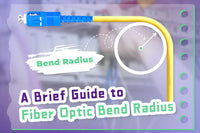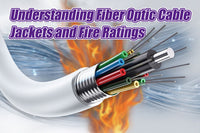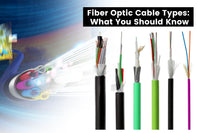Contents
Optical fibers facilitate communication via optical signals with a speed surpassing other mediums. However, compared to copper cables, fiber optic cables, containing delicate glass fibers, are more susceptible to damage and breakage. Armored fiber optic cables are equipped with a strong physical protective layer, enhancing their durability. Armored fiber cables offer enhanced resistance to pressure, harsh environments, and gnawing. What are armored fiber optic cables? Are there different types of armored fiber optic cables? How do armored fiber optic cables differ from non-armored ones? This article provides a basic overview of armored fiber optic cables.
What is Armored Fiber Optic Cable?
The armored fiber optic cable is a variant of fiber optic cable enhanced with additional protective layers made of metal or polyethylene. The multi-layer outer jacket is designed to enhance its ability to withstand external forces, stretching, and adverse environmental conditions like moisture and animal bites. Armored fiber optic cables offer durability and flexibility, making them ideal for indoor, outdoor, and tight places. However, they typically have a specified bend radius and should not be bent excessively during installation.
A typical armored fiber optic cable has multiple layers to protect the fiber. While the design and structure of armored fiber optic cables may vary, they generally contain the following components:
- Outer Jacket: Armored fiber cables usually have a protective outer jacket on the outermost layer made of PVC or PE, which protects the inner components from liquids, chemicals, wear, and UV.
- Armor Layer: Armored fiber optic cables feature a typical armor layer to enhance mechanical resistance. The armor layer is often made of metallic materials such as steel or aluminum or non-metallic materials like polyethylene and yarn. The armor layer is difficult to cut or burn.
- Inner Jacket: The inner jacket is a protective flame-retardant sheath between the fiber and armor layer to support the inner fiber cable, including strength members and fillers such as buffer coatings and gel-like substances.
- Optical Fiber: It is the core part of an armored fiber optic cable. The armored cablehas one or more optical fibers, each with cladding, designed to transmit data signals.
Other components of armored fiber may include strength members made from yarns such as glass, fiber, and aramid (e.g. Kevlar), as well as ripcords inside the armor layer to help cable stripping.

Benefits of Armored Fiber Optic Cable
- Enhanced Resistance to Mechanical Strength
Compared to standard fiber optic cables, armored cables offer greater resistance to physical damage from shock, pressure, or tension. They are designed to withstand stretching or are less prone to damage from biting. This feature makes armored fiber optic cables ideal for high-activity places.
- Durability in Harsh Environments
The armor provides resistance to moisture, sunlight, chemical erosion, abrasion, and heavy loads. Armored fiber optic cables are also less sensitive to temperature changes. The robust design makes them ideal for extreme environments, such as outdoor installation, burial underground, or industrial settings.
- Adaptability
Armored fiber optic cables retain certain flexibility and ease of installation while improving protection. Compared to the use of fiber conduits, they are more suitable for applications with complex wiring and limited space. Like standard fiber optic cables, armored fiber cables come in diverse configurations, such as single-mode and multimode, and are available in various connector and armor design options.
- Lower Maintenance Costs
Armored cables are durable and resistant to damage, which can largely reduce the maintenance cost over time.
Armored Fiber Cable Types
There are different armored fiber optic cables based on different classifications. Here are three common classifications of armored fiber optic cables.
Based on Metal Armor Types
Based on metal armor, armored fiber optic cables can be divided into two types: corrugated and interlocking types. Corrugated steel armored fibers use coated stainless steel strips wrapped longitudinally around the cable. Corrugated armored fiber optic cables provide excellent mechanical properties and rodent resistance, which are suitable for outdoor use and direct burial. Interlocking armored fibers use an aluminum sheath spirally wound around the fiber cable, offering durability and compression resistance. Interlocking armored fiber optic cables are suitable for both indoor and outdoor applications.
In addition to these two types, armored optical cables also feature other different metal tube designs. There are square lock armored, spiral steel armored, steel wire armored, and steel wire braided armored fiber optic cables.

Based on Installation Methods
Armored fiber optic cables can be either pre-terminated or field-terminated. Pre-terminated armored fiber optic cables are generally used for indoor uses, which is time-saving for many installers. Pre-terminated armored cables mainly consist of two types: armored fiber patch cables and armored fiber trunk cables. Field-terminated armored fiber optic cables perform better in outdoor applications, but terminating armored fiber optic cables with robust armor can be a complicated thing.
Based on Application Environments
Different types of armored fiber cables are required for different installation environments.
Indoor armored fiber cables are used for wiring inside buildings, especially in high-density wiring environments like data centers. Both loose-tube and tight-buffered armored fiber optic cables can be used indoors, with a preference for the tight-buffered type. Indoor armored cables often feature lightweight interlocking armor, and in some cases, they use LSZH jackets to enhance flame retardancy. In addition, specialized indoor/outdoor (I/O) armored fiber optic cables are becoming increasingly popular due to their convenience in establishing network connections between buildings without switching cables.
An armored fiber optic cable used for outdoor usually features a loose-tube armored construction with centered strong members and waterproof gels inside the inner jacket. Among outdoor armored fiber cables, light armored fiber cables with plastic armor are often used for moderately challenging environments, whereas heavy armored fiber cables with reinforced metal sheaths are typically used as direct burial fiber optic cables to protect against damage and animal bites. Outdoor armored fiber optic cables are suitable for environments that require additional protection.

Armored vs. Non-armored Fiber Cables
Choosing between armored and unarmored cables requires full consideration of the deployment environment, network requirements, and budget. One of the most important things you need to consider is the physical protection you need in the network installation.
Non-armored fiber optic cables are suitable for indoor or outdoor applications where the physical damage is very low. These cables are light and simple in structure, offering cost advantages in terms of material, transportation, storage, and installation. If you have a limited budget and don’t require a very durable fiber optic cable, non-armored fiber optic cables are enough for you.
Armored fiber optic cables are preferred for harsh environments with high physical risks, such as industrial sites, underground facilities, and areas infested with harmful animals. Though armored fiber optic cables require a higher initial investment, you don't have to spend much on maintenance. However, compared with non-armored fiber optic cables, they take up more space, are less flexible, and may be more difficult to install.
Final Words
Armored fiber optic cables ensure durability, harsh environmental resistance, and long service life. Understanding armored fiber cables helps you find the best fiber optic cables to fit your own requirements.
For more information on this topic, you can keep up on our blogs. While VCELINK offers general and basic information for our customers and other visitors to the website, it’s not professional advice.



Be the first one to comment.
Leave a comment